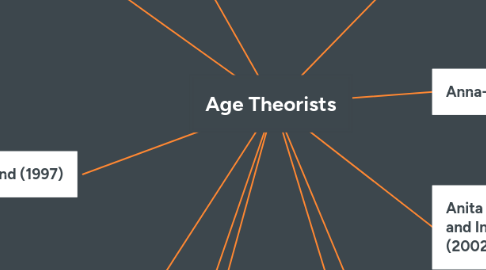
1. Gary Ives
1.1. He asked the question "do people speak differently because of their age?" to 63 teens in a school in West Yorkshire
1.1.1. 100% of the teenagers said yes, concluding his argument - that as we get older, our language becomes more standard. According to Ives, throughout our life we will stop swearing and eventually come more 'posh'.
1.2. He also asked multiple 17 year old in the same school to recall slang words that they have used in their life (including "bare" and "chatting rubbish"). The students claimed that they felt this language was specific to theyr age, and not used or even understood by other generations.
2. Ignacio Palacios Martinez (2011)
2.1. Focused his research on the use of negatives within teenagers.
2.1.1. He found that teenagers use negatives more frequently than adults.
2.1.2. Roughly 1/3 of negatives occurred in orders, suggestions and refusals.
2.1.3. Typical negative phrases included 'no way', 'nah', 'nope', 'dunno', 'I couldn't give a toss' and the non standard use of 'never'.
2.2. Martinez argues that teenagers are more direct than adults when they speak, as adults are more conscious of what they say and how they say it, in fear of coming across as too direct of threatening to a speaker's face.
3. Unni Berland (1997)
3.1. Berland's research focused on the use of tags such as 'innit', 'yeah', and 'right' within teenagers.
3.1.1. He suggested evidence towards that boys used 'okay' more than girls but both sexes used 'innit', 'right' and 'yeah' in equal measures.
3.2. He determined that social class was also an important factor as well as age.
3.2.1. He found that 'innit' was more commonly used among working class teenagers while 'yeah' was used more by the middle class.
4. Christopher V. Odato (2013)
4.1. His study focused on the use of 'like' in children's speech.
4.1.1. He identified three stages of using 'like' as a discourse marker...
4.1.1.1. Stage 1: Children use 'like' infrequently and in 'only a few synaptic positions' - mainly at the beginning of a clause: 'Like you won easily.'
4.1.1.2. Stage 2: Children use 'like' more often and in 'a greater number of positions'. Girls tended to move to this stage aged 5, boys when they were 7.
4.1.1.3. Stage 3: Children now use it more frequently in other positions, such as before a prepositional phrase: 'Look at how yours landed like right on the target.' Again, girls moved to this stage at an earlier age than boys.
4.1.2. He found that children as young as 4 were using 'like'.
5. Douglas S. Bigham
5.1. Created and defined the term 'emerging adulthood' to describe how important life events are more likely to occur post-18
5.2. Develops Eckert's theory that language used by a 20 year old woman would not be the same as a 20 year old woman who's married and has children due to the different concepts of age.
6. Zimmerman
6.1. His theory is that graffiti, music and media influence teenage speech.
6.2. This is the same Zimmerman out of Zimmerman and West.
7. Penelope Eckert (2003)
7.1. Found That Teenagers...
7.1.1. Use 'Like' and 'Okay' as Discourse Markers
7.1.2. Include Rising Intonation Within Speech
7.1.3. Include Multiple Negation Within Speech
7.2. She Claimed That "Adolescents (teenagers) do not all talk alike; differences among adolescents are probably far greater than speech differences among any other age group."
7.3. She Categorised The Three Types of Age...
7.3.1. Chronological (number of years since birth)
7.3.2. Biological (physical maturity)
7.3.3. Social (linked to life events such as marriage and having children)
8. Anna-Brita Stenstrom
8.1. She claims that teenagers use a range of features, including...
8.1.1. Irregular Turn Taking
8.1.2. Overlaps
8.1.3. Indistinct Articulation
8.1.4. Word Shortening
8.1.5. Teasing and Name Calling
8.1.6. Verbal Duelling
8.1.7. Slang
8.1.8. Discuss Taboo Topics
8.1.9. Language Mixing From Other Cultures
9. Anita Stenstrom, Gisle Andersen and Ingrid Kristine Hasund (2002)
9.1. Their study focused on non-standard grammatical features.
9.1.1. They found that common features of teenagers include: multiple negation, use of 'ain't', ellipsis of auxiliary verbs, non-standard pronouns (e.g. theirselves).
